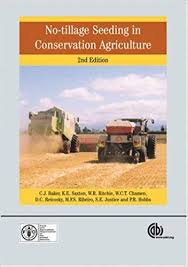Chapter content
NO-TILLAGE SEEDING in CONSERVATION AGRICULTURE 2nd Ed |  |
Contents | |
| Contributors | vii |
| Foreword to the Second Edition (Shivaji Pandey and Theodor Friedrich) | viii |
| Preface | ix |
| 1 The 'What' and 'Why' of No-tillage Farming (C John Baker and Keith E Saxton) | 1 |
| 2 The Benefits of No-tillage (Don R Reicosky and Keith E Saxton) | 11 |
| 3 The Nature of Risk in No-tillage (C John Baker, W (Bill) R Ritchie and Keith E Saxton) | 21 |
| 4 Seeding Openers and Slot Shape (C John Baker) | 34 |
| 5 The Role of Slot Cover (C John Baker) | 60 |
| 6 Drilling into Dry Soils (C John Baker) | 74 |
| 7 Drilling into Wet Soils (C John Baker) | 85 |
| 8 Seed Depth, Placement and Metering (C John Baker and Keith E Saxton) | 99 |
| 9 Fertilizer Placement (C John Baker) | 118 |
| 10 Residue Handling (C John Baker, Fatima Ribeiro and Keith E Saxton) | 134 |
| 11 Comparing Surface Disturbance and Low-disturbance Disc Openers (C John Baker) | 159 |
| 12 No-tillage for Forage Production (C John Baker and W (Bill) R Ritchie) | 168 |
| 13 No-tillage Drill and Planter Design - Large-scale Machines (C John Baker) | 185 |
| 14 No-tillage Drill and Planter Design - Small-scale Machines (Fatima Ribeiro, Scott Justice, Peter Hobbs and C John Baker) | 204 |
| 15 Managing a No-tillage Seeding System (W (Bill) R Ritchie and C John Baker) | 226 |
| 16 Controlled Traffic Farming as a Complementary Practice to No-tillage (W C Tim Chamen) | 236 |
| 17 Reduced Environmental Emissions and Carbon Sequestration (Don C Reicosky and Keith E Saxton) | 257 |
| 18 Some Economic Comparisons (C John Baker) | 268 |
| 19 Procedures for Development and Technology Transfer (C John Baker) | 277 |
| References | 301 |
| Index | 316 |
